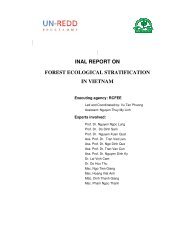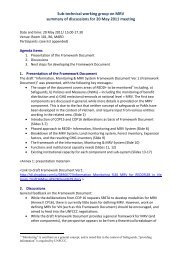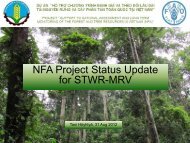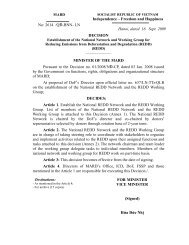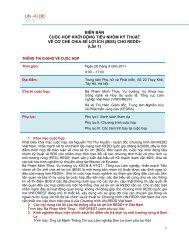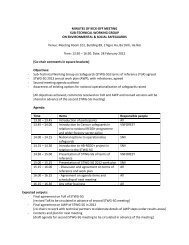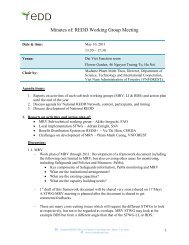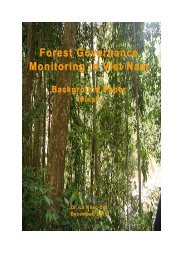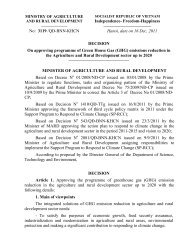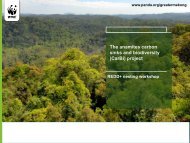TERMS OF REFERENCE Title: Joint workshop ... - REDD - VietNam
TERMS OF REFERENCE Title: Joint workshop ... - REDD - VietNam
TERMS OF REFERENCE Title: Joint workshop ... - REDD - VietNam
You also want an ePaper? Increase the reach of your titles
YUMPU automatically turns print PDFs into web optimized ePapers that Google loves.
<strong>TERMS</strong> <strong>OF</strong> <strong>REFERENCE</strong><strong>Title</strong>:<strong>Joint</strong> <strong>workshop</strong> MPI SD and CP project and MARD UN-<strong>REDD</strong>Viet Nam Programme on mainstreaming SustainableDevelopment and Climate Change in Development planning atRegional and provincial levelDuty Station:Da Lat city of Lam Dong ProvinceDuration and timing: 2 working days, 24-26 May, 2011 (tentatively) and additional 3days preparation timeStarting date:Project ID and title:Reporting:• BACKGROUNDUNDP/MPI - “Sustainable Development and ClimatePlanning” project – ID: 00057013FAO/UNDP/UNEP/MARD UN-<strong>REDD</strong> Viet Nam ProgrammeReports to the NPD of SD & CP Project and UN-<strong>REDD</strong> <strong>VietNam</strong> ProgrammeThe Department of Science, Education, Natural Resources and Environment/ Ministry ofPlanning and Investment’s (DSENRE/MPI) is implementing the UNDP project“Sustainable Development and Climate Planning” over the period from 2009 - 2011.This project focuses on various aspects of sustainable development planning and climatechange mainstreaming in development planning processes. One of its key outcomes it toenhance capacity and inform the planning system and planner on how to mainstreamsustainable development and climate change into their strategies and plans (SEDP).The UN-<strong>REDD</strong> Viet Nam Programme, a joint FAO, UNDP and UNEP effort, is thecollaborative UN programme which aims at assisting developing country to establishcapacity and institutions to effectively implement <strong>REDD</strong> (Reduced Emission from ForestDegradation and Deforestation). In Vietnam, UN-<strong>REDD</strong> is implemented by the Ministryof Agriculture and Rural Development. Up to date, the project focussed on developingtechnical and institutional capacities at national level and Lam Dong province.One of the key challenges so far in Vietnam is how to develop effective mechanism tomainstream climate change in development planning. The case of <strong>REDD</strong>+ is interestingand challenging as <strong>REDD</strong>+ is already being implemented at pilot scale but will benational in future 1 . It remains unclear what the financial implications are but <strong>REDD</strong>+will alter spatial and land use planning as well will impact both positively and negativelythe planning targets set. Until now, no wider assessments have been done, but sectorsimpacted are environment and natural resources, cash crops, mining, industry (furniture,pulp and paper), transportation (new road trajectories) and water supply.1 It is not certain when <strong>REDD</strong>+ will be formally accepted as a financial mechanism under UNFCCC. The <strong>REDD</strong>+countries will implement the <strong>REDD</strong>+ activities in accordance to national circumstances and capacities in thecontext of the provision of adequate and predictable support from development partners. Furthermore,<strong>REDD</strong>+ may not be suitable and applicable for all provincies. Therefore, nationa-wide implementation shouldbe understood as national policies rather than “pure” geographical meaning.
As such, <strong>REDD</strong>+ will have a wider impact on social-economic development in ruralareas where the key beneficiaries – local communities and ethnic minorities - live.Forests have often been a key element for local development. Under unfavourableconditions that has led to forest degradation and ultimately deforestation. <strong>REDD</strong>+ is notdesigned to end use of forest resources, instead it is designed to enable forests and forestland to recover and to allow local and national economic interests to be based onsustainable extraction of forest products. International donors are interested to support for<strong>REDD</strong>+ in Vietnam on a large scale that may cover all provinces with forest cover 2 .This event is aimed to engage the planning sector in the <strong>REDD</strong>+ debate as well asdevelop cross sectoral links to develop approaches to mainstream climate change inplanning processes.The SD&CP project is developing Sustainability Assessment (SA or SEA Plus) Tool andsupporting capacity strengthening in planning for Highland Central Steering committee.These developments are supportive to explore suitable approaches to maximize <strong>REDD</strong>+benefits with CC and sustainable development. The attached policy note provides a clearoutline of these links.2) OBJECTIVES <strong>OF</strong> THE ASSIGNMENTThe objectives of this joint activity are:• Develop a clear and common understanding about <strong>REDD</strong>+, its wider sectoralimpact and development planning institutions on <strong>REDD</strong>+ benefits andchallenges;• Discuss to establish a framework on how <strong>REDD</strong>+ can enable provinces and theCentral Highland Steering Committee on how to strengthen sustainabledevelopment and climate change mainstreaming with emphasis on meetingnational set development targets;• Agree on a follow up actions.It is anticipated that this <strong>workshop</strong> explores how:• Climate change mitigation activities with emphasis on <strong>REDD</strong>+ plus can be bestmainstreamed in the SEDP process;• Identify challenges and possibilities for potential action which fed into thenational climate change mainstreaming agenda;• Identify how <strong>REDD</strong>+ development can facilitate the strengthening of on-goingsustainable development.2 Even when <strong>REDD</strong>+ is accepted as a financial mechanism by COP, it is still considered as one of manysolutions/measures to halt deforestation and degredation. In case of Vietnam, <strong>REDD</strong>+ should be introduced inline with PES policies (esp, in the meeting for policy-makers), rather than being mentioned alone.
3) SCOPE <strong>OF</strong> WORKTo achieve this objective, 2 day meeting is proposed in central highland.Venue: A hotel/resort in the central highland region. May be Da Lat City of Lam Dong.Participants:• Planners active in the Department of Planning in the six target provinces (LamDong, Gia Lai, Kon Tum, Dak Lak, Dak Nong and Quang Nam);• Members of the Central Highland Committee;• MARD and MPI staff active in <strong>REDD</strong>+ and Climate change mainstreaming;• DARD staff involving in <strong>REDD</strong>+ and Climate change mainstreaming (LamDong, Gia Lai, Kon Tum, Dak Lak and Dak Nong);• Steering committee and National Assembly Delegation in Highland central regionthose are active in climate change mainstreaming and/or <strong>REDD</strong>+;• Provincial mass media organizations.Total anticipated: 45.ProcessThe meeting involves:• Presentation and discussions (full day);• Field visit (morning and early afternoon session);• Identify lessons learnt and follow up (afternoon session).The process will consists of active learning through a mixture of presentations,discussions and the use of impact assessment tools. The process is presented below:• Climate change mainstreaming in development planning: the case of <strong>REDD</strong>+:• Introduction to climate change and international developments• Mitigation + adaptation• Mitigation, importance of forestry sector• <strong>REDD</strong>+ (Reduced Emission of Forest Degradation and Deforestation) toaddress climate change;• Challenges:• <strong>REDD</strong>+ is not only about forest conservation but about sustainabledevelopment• More mutual benefits from forest;• Spatial impacts;
• Financing option and benefit sharing mechanisms;• Institutional issues to be considered.• From regional planning to provincial planning:• Regulation and procedures for regional planning:• Issues in coordination of provincial SEDPs• Develop coordination mechanism between provinces• How to regional SEDP related to the provincial planning• <strong>REDD</strong>+ (by local government) experiences:• What are the impacts for socio-economic provincial development andenvironmental protection;• How those <strong>REDD</strong>+ benefits enable the government to achievedevelopment targets/ indicators.The afternoon sessions: discussions• How to Integrate <strong>REDD</strong>+ and climate change in SEDP• Use of S(E)A tools to assess Impact of <strong>REDD</strong>+ on:• Meeting indicators• Forest cover and quality of forests• Ecosystem services such as water supply, water quality andsedimentation• Biodiversity• Conservation of wetlands and cloud forests• Stimulating non forest dependent economic growth• Information needs• What type of planning instruments are required to stimulatealternative growth strategies• Define steps for future work:• Learning between provinces on how to mainstream <strong>REDD</strong>+ indevelopment planning;• Develop ideas on how the Central Highlands Committee to partly takelead in developing regional planning and mainstream sustainable
development.Field visit will be to the UN-<strong>REDD</strong> project site and involves:• Presentation of the <strong>REDD</strong>+ process so far and lessons learnt;• Implementing <strong>REDD</strong>+ and contribution to sustainable development;• Implications for planning at commune, district and provincial level.4) FINAL PRODUCTS***The anticipated outputs are:• A draft outline for Climate change mitigation/<strong>REDD</strong>+ mainstreaming;• Testing of SA (SEA plus) tool;• Assessment of future TA needs for regional NAMA/<strong>REDD</strong>+ based development.5) DEGREE <strong>OF</strong> EXPERTISE AND QUALIFICATIONS• The project will require the inputs from:• International and national Technical Specialist from the UN SD & CCproject and UN-<strong>REDD</strong> Viet Nam Programme;• Vietnamese language facilitator. The facilitator will be recruitedexternally. The proposed requirements are:• Degree in social sciences, economics or a natural resourcerelated subject;• Experience in facilitating meetings and <strong>workshop</strong>s with forVietnamese government;• Proven facilitation skills;• English language ability.6) ADMIN SUPPORT AND <strong>REFERENCE</strong> DOCUMENTSThe PMUs from UN-<strong>REDD</strong> and SD and CP will administrative supportRelevant documents:• SD and CP inception report• UN-<strong>REDD</strong> inception report• http://www.unredd.org/UN<strong>REDD</strong>Programme/CountryActions/<strong>VietNam</strong>/tabid/1025/language/en-US/Default.aspx• Draft SEDP and report on mainstreaming <strong>workshop</strong> for the SEDP (Social
Economic Development Plan) (available on request)• Vietnam Benefit Distribution Study: http://www.unredd.org/Publications/tabid/587/Default.aspx.7) COST ESTIMATIONS AND RESPONSIBILITY <strong>OF</strong> PARTIES12,800USD including <strong>workshop</strong> costs, fees for speakers, DSA etc.Responsibilities of each party are described in the annex 3.8) CONSULTANT PRESENCE REQUIRED ON DUTY STATION/UNDPPREMISESNONE x PARTIAL INTERMITTENT FULL-TIMEAnnex 1: Tentative Workshop Agenda (24-26 May 2011) in Da lat city, Lam DongProvinceDay 0, 24 Activity contentResponsibleMay 201117:00 Welcome participants and check in Hotel at Projectabout 5pm18:00 Dinner with the introduction session ProjectDay 1, 25May 201107:30–08:00 Registration Project08:00–08:30Opening remarks by the Representative of PPC,MPI, MARD and Highlands Steering Committee To be advised(Standing member)08:30–09:15 Climate change and impacts on Socio-economicdevelopment of Highland region09:15–10:00Needs and Proposed Approaches formainstreaming climate change into DevelopmentStrategy, SEDP10:00-10:15 Break10:15-11:00 <strong>REDD</strong>+ as solution for effective response toclimate change and socio-economicdevelopment, <strong>REDD</strong>+ in Vietnam11:00 – 11:30 Report on Implementation of phase 1, plannedactivities for phase 2Representative of NTP-RCC Office (MONRE)Consultant of UN-<strong>REDD</strong>, aNguyen Khac HieuMONREConsultant of ProjectSD&CP, a ChungDirector of UN-<strong>REDD</strong>Programme, Office ofNational <strong>REDD</strong>UN-<strong>REDD</strong> + Office
11:30-13:30 Lunch13:30-14:15 Provincial <strong>REDD</strong>+ Working group Lam Dong DARD14:15-15:00 <strong>REDD</strong>+ under view point of sustainability SD&CP & UN-<strong>REDD</strong>assessment15:00- 15:15 Break15:15- 16:30 Group discussion on ways to bringing <strong>REDD</strong>+into SEDPs and needs to work togetherministries and provincial authoritiesDiscussion in groups16:30- 17:00 Plenary discussion ChairmenDay 2, 26May 201107:00- 12:00 Field visit to Phu Son commune(visit forest, meet local villagers, talk with themon activities done and lunch, detailed by <strong>REDD</strong>design)13:30 – 15:30 Road map to mainstreaming <strong>REDD</strong>+Follow up collaborationOrganization by UN-<strong>REDD</strong>Chairman
Annex 2: List of Participants to be invitedNo. Organization <strong>Title</strong> Quantity1 Vietnam Administration of Forestry(VNFOREST)/MARDLeader 12 Viet Nam Administration of Forestry /MARD Experts 2-33 UN Communcations Team 14 Member(s) of National <strong>REDD</strong>+’s SteeringExperts 2Committee (with at least one member from MPI-Agriculture Economics Dept)5 DSENRE/MPI Leader 16 DSENRE/MPI Experts 46 Department of Argicultural Economic Issues/MPI Expert 17 FERD and one member of ODA Study Team Expert 28 UNDP Hanoi PO 29 Highland Steering Committee Leader 2-310 Highland Steering Committee Experts 1011 Lam Dong People’s Committee/DARD Leader 112 Lam Dong DARD Experts 213 Di Linh and Lam Ha District People’s Committees Leaders 214 <strong>REDD</strong>+ Working group15 National Assembly Delegation in Highland centralregionMembers 216 DPI of Lam Dong Province Experts 217 DPI of Gia Lai Province Experts 218 DPI of Kon Tum Province Experts 219 DPI of Dak Lak Province Experts 2
20 DPI of Dak Nong Province Experts 221 DARD of Gia Lai Province, chi cuc Lam Nghiep GiaLai (Nguyen Ngoc Ran, Chi cuc truong)Experts 222 DARD, in which 1 prepresentative of DARD, 1 ofForest Divion of Kon Tum Province (related toDecree 99)23 DARD of Dak Lak Province (compound are sameditto)24 DARD of Dak Nong Province (compound are sameditto)Experts 2Experts 2Experts 225 Quang Nam DPI Experts 226 UN-<strong>REDD</strong> Consultants/Experts27 SD&CP Consultants/Experts28 Mr. Thanh Cao, Chairman of VUSTA Kontum Leader andExpert29 Lam Dong Province Television Journalist 230 Bao VIR, Tap kinh Kinh te Du bao Journalist 2Total: 30 excl. Project staff(Mr Chung to prepare TOR for Mr Hieu – Presentor then send Ms Huyen – <strong>REDD</strong> forprocedures).332
Annex 3: Responsibility of Co-organizersNo Activity content Responsible1 Commend and finalize for TOR, Workshop Agenda,PresentationProject: UN-<strong>REDD</strong> andSD&CP2 Prepare and send Invitation letter Project UN-<strong>REDD</strong>3 Order Presentations, Opening Speeches (see detailsin annex 3.1 below)Project: UN-<strong>REDD</strong> andSD&CP4 Book Hotel and prepare logistics for <strong>workshop</strong>, hire Project SD&CPfacilitator5 Contact for visit pilot site Project UN-<strong>REDD</strong>6 Payment for Hotel costs (shared 50/50)
Annex 3.1: Responsibility of Co-organizers for presentations1 Climate change and impacts on Socio-economic UN-<strong>REDD</strong> Programmedevelopment of Highland region2Needs and Proposed Approaches for mainstreaming Project SD&CPclimate change into Development Strategy, SEDP3 <strong>REDD</strong>+ as solution for effective response to climate UN-<strong>REDD</strong> Programmechange and socio-economic development4 <strong>REDD</strong>+ in Vietnam, Report on Implementation of UN-<strong>REDD</strong> Programmephase 1, planned activities for phase 25 Report on <strong>REDD</strong>+ in pilot site UN-<strong>REDD</strong> Programme/Lam Ha, Di Linh PC6 <strong>REDD</strong>+ under view point of sustainablityassessmentUN-<strong>REDD</strong> Programme foran expert7 Field visit to the UN-<strong>REDD</strong> Programme site Project UN-<strong>REDD</strong>/LamDong DARD8 Write Workshop Report Project SD&CPAnnex 3.2: Preparation ProgressDate Activity Location4 May Meeting to discuss on TOR and responsibility UN-<strong>REDD</strong> Programme9 MayFinalize of TOR and responsibilityProject SD&CP9 May Hire experts and order presentations UN-<strong>REDD</strong> Programme,SD&CP project9 May Contact hotel for reserve UN-<strong>REDD</strong> Programme10 May Prepare and send Invitation letter, Book Airtickets UN-<strong>REDD</strong> Programme,SD&CP project15 May Check preparations UN-<strong>REDD</strong> Programme,SD&CP project20 May Final check before depart Hanoi to Lam Dong UN-<strong>REDD</strong> Programme,SD&CP project23 May Depart Hanoi for Da Lat24-26 Organize WorkshopDa Lat, Lam DongMay10 June Write Workshop Report Project SD&CP
Annex 4: <strong>REDD</strong>+ and Development Planning: Transition towards a future ofSustainable Development1. Background<strong>REDD</strong>+ is a key component of a future climate regime. It is a core element of internationalagreement through the so called “Bali roadmap”. Over the recent years it has been one of theareas where most progress has been booked. To the extent that some countries (Norway, butalso France, US and leading developing nations such as Brazil, Indonesia and Vietnam) havebeen moving the agenda forwards.Based on recent developments, <strong>REDD</strong>+ will significantly alter forest management practices.<strong>REDD</strong>+, is not about conservation alone but about sustainable management of forest andforest land resources to generate GHG emissions reductions and enhance forest (both aboveand below ground) carbon stocks. While <strong>REDD</strong>+ builds on Payment for EnvironmentalServices principle, its scale and magnitude of implementation imply wide-spread change inforest management as well in the rural economic development and resource allocation. Closeto 38% of all land is forested in Vietnam which makes forestry the key land use sector.However, other resources are competing for forest lands, in particular mining, infrastructuredevelopment, cash crop development (for exports) and hydropower (despite improvedupstream management of forests leads to improved performance of dams).Vietnam has been successful during the start-up phase of <strong>REDD</strong>+, in particular throughassistance of the UN-<strong>REDD</strong> Programme, and is currently preparing for scaling up <strong>REDD</strong>+through implementation at provincial level, with the assistance of the United Nations (UN-<strong>REDD</strong> Phase II with more than $100 million budgeted), the World Bank through its ForestCarbon Partnership Facility ($3.6 million) and bilateral support (e.g. GTZ, AusAid, JICA,Finland). For it to be effective <strong>REDD</strong>+ has to operate at national scale and if internationalgoals are to be achieved, <strong>REDD</strong>+ has to be implemented globally and encompass all tropicalforests. The development of <strong>REDD</strong>+ will lead to significant opportunities to pursue a widersustainable development agenda, in particular through integration into provincial policyinstruments such as the SEDP and the Forest Development Plan. Similarly, immediateimplications for the wood processing industry (furniture, pulp, wood chips) and spatialplanning are significant and have to be incorporated in wider development planning.Vietnam has progressed on a sustainable forest agenda through Decree No. 99 on the Policyfor Payment for Forest Environmental Services, which was issued by the Prime Minister onSeptember 24 2010. This Decree regulates the policy for payment for forest environmentalservices in Viet Nam, including:• Types of environmental service that the users pay to the suppliers subject to this Decree.• Suppliers and users of forest environmental services.• Management and use of the payment from forest environmental services.• Rights and obligations of suppliers and users of forest environmental services.• Responsibilities of state management agencies at various levels and of differentsectors in implementing payment for forest environmental services.The provisions of this Decree shall apply to state agencies; organizations, households,individuals, village communities in the country; Vietnamese residing overseas, foreign
organizations and individuals with operations relating to supply, use, and payment for forestenvironmental services and management of the payment from forest environmental services.The Decree defines types of forest and types of forest environmental services entitled topayment for forest environmental services including services from <strong>REDD</strong> mechanism andPrinciples of payment for forest environmental services.In particular, because <strong>REDD</strong>+ could trigger significant changes in rural economies andenable local communities/communes to move towards sustainable development. This paperis meant to identify these issues and propose how the planning sector can be involved in<strong>REDD</strong>+ more effectively.2. Planning Issues relevant to <strong>REDD</strong>+ in Vietnam<strong>REDD</strong>+ will have an impact on wider social-economic development in rural areas. Forestshave often been a key element for local development. Under unfavourable conditions that hasled to forest degradation and ultimately deforestation. <strong>REDD</strong>+ is not designed to end use offorest resources, instead it is designed to enable forests and forest land to recover and toallow local and national economic interests to be based on sustainable extraction of forestproducts. International donors are interested to support for <strong>REDD</strong>+ in Vietnam on a largescale that may cover all provinces with forest cover.The following issues are emerging as being relevant for the planning sector:• Anticipated emission reduction/carbon stock enhancements and benefit sharingarrangement.• Overall emission reductions, expressed in CO2e MT, will ultimately define thepotential benefit from <strong>REDD</strong>+. Given a certain international market price forcarbon, this will ultimately define the financial benefits to Vietnam. <strong>REDD</strong>+has three eligible activities that hold high potential for Vietnam:• Reduction in the rate of deforestation• Reduction in the rate of forest degradation• Enhancement of carbon stocksThe variety of ecological, geo-physical, climatic and socio-economicconditions in Vietnam require careful analysis of where each of these activities(or a combination thereof) can be most effectively implemented. Planningshould be driven by anticipated <strong>REDD</strong>+ benefits and how that can addressdeforestation and forest degradation drivers. A framework for opportunity costanalysis for <strong>REDD</strong>+ to support this analysis is currently under development.Additionally, <strong>REDD</strong>+ should be considered always as a side-benefit of otheractivities; for instance the rehabilitation of mangroves and coastal forest areasas a coastal defense mechanism can have benefits under <strong>REDD</strong>+ that canoffset some of the costs of implementation.• Benefit sharing arrangement are important from a planning perspective, keychallenges are:• How to define who is entitled to what and how to best use resources?• How to avoid the “Dutch Disease” in local economies, e.g. thedevelopment of economies dependent on financial transfer but withoutlong term economic investments.
The UN-<strong>REDD</strong> Programme has undertaken several studies on BenefitDistribution and these are being discussed with stakeholders in Hanoi andLam Dong province (UN-<strong>REDD</strong> pilot province).• <strong>REDD</strong>+ should ultimately facilitate the sustainable development of low carbonclimate resilient livelihoods. <strong>REDD</strong>+ will be a temporary funding opportunity of 10-15 years in which to achieve improved forest management and forest informationmanagement, elimination or reduction of drivers of deforestation and forestdegradation, as well as sustainable rural livelihoods based on a sustainable use offorest resources. This requires:• Define options for the post-<strong>REDD</strong>+ period, through investing in alternativelivelihood options and sustainable use of forests. Rural industrialization andagricultural intensification, moving away from producing commodity to highvalue crops, as well as more localized processing will reduce pressure onforests. <strong>REDD</strong>+ can initiated these changes if it is placed in a wider ruraldevelopment context.• Assess implications on spatial development with regards to development inother sectors such as mining and hydropower development. Mining, inparticular open pit.• Make an assessment of the sustainable productive capacity of all forests in Vietnam.<strong>REDD</strong>+ will not only enhance the carbon stock of the forest, it will also increaseproductivity, particularly on the large expanse of currently degraded forest land. Itmay be expected, therefore, that the domestic supply of timber for the woodprocessing industry will gradually increase to its optimal state. This may besubstantially higher than the current production volumes. This implies that economicdevelopment options as well as their costs and benefits need to be assessed.• Integrate <strong>REDD</strong>+ into special planning and development planning though the use ofSEA. This involves the use of SEA to better plan for:• Ensuring co-benefits. Biodiversity and additional water capturing. SEA willenable better planning to ensure co-benefits such as biodiversity and watermanagement are better integrated in provincial <strong>REDD</strong>+ designs.• Initiate longer term initiatives, paid through <strong>REDD</strong>+ revenues, that facilitatesustainable reduction/elimination of drivers. This could include bamboo-basedindustries, renewable energy sources (to address firewood collection),intensified agriculture and agribusiness development.Avoiding deforestation is proposed to be included in the SEDP. Recent developments inPayment of Environmental Services provide an excellent framework to ensure thedevelopment of a proper institutional framework for <strong>REDD</strong>+. However, effectiveimplementation, thus leading to significant reduction in GHGs, is possible but should takeinto account efforts to address impacts of <strong>REDD</strong>+.<strong>REDD</strong>+ is the first nationwide effort to reduce GHG emissions which involves climatefinancing. Despite its specifics, <strong>REDD</strong>+ might provide insights in what green economicgrowth implies. Besides it can set a precedent on how to initiate social economic changetowards developing low carbon and high growth paths based on sustainable natural resourceuse.• Next steps
To strengthen capacity in the planning sector with <strong>REDD</strong>+ and taken the above into accountthe following steps are proposed:• Together with UN-<strong>REDD</strong> initiate an SEA on a <strong>REDD</strong>+ program in fiveprovinces in Vietnam to assess what key impacts are likely to occur. UN-<strong>REDD</strong> Phase II is expected to start in the second half of 2011 withimplementation in five provinces. During the current Phase I of UN-<strong>REDD</strong> theSEA could be developed and implemented in Lam Dong province.• Within the SEDP, deforestation and actions to stop it are likely to be included,this could be made more explicit through referencing to <strong>REDD</strong>+.• SD and CC project plans to support the Central Highlands committee and thedevelopment of the Central Highlands master-plan. The Central Highlands arestill exposed to significant deforestation and are targeted by various <strong>REDD</strong>+initiatives.• Initiate research into social economic development strategies for <strong>REDD</strong>+provinces. Given the temporary nature and significant potential influx of fundsas opposed to average income, effective use depends on the ability ofcommunes and province to initiate not forest dependent sustainabledevelopment, which requires technical assistance from MPI.




